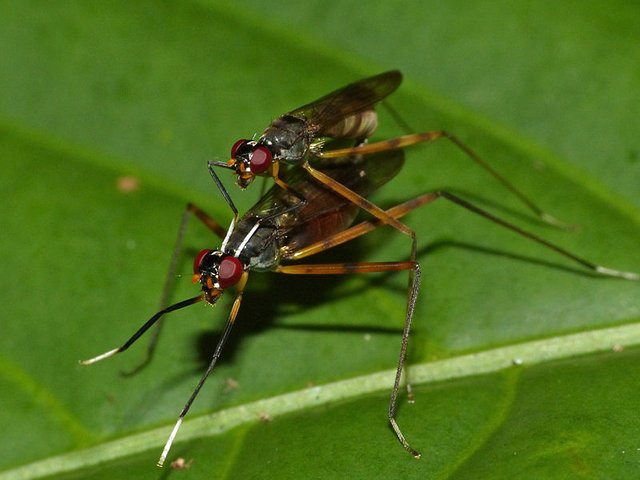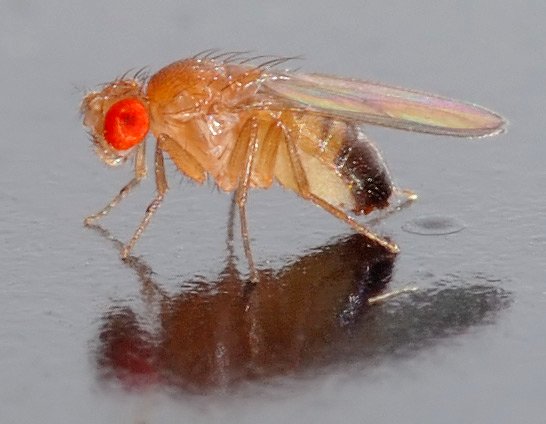Dumbfounding appraisal of fly species suggests that there might be more fly species than researchers and scientists actually think. And why should we care about the biodiversity of flies?
Introduction
_mating_(15496457209).jpg) [License: Wikimedia Commons]: Image Link
[License: Wikimedia Commons]: Image Link Our planet's diverse varieties of organisms can be examined through the concept of biological diversity. The idea behind the concept "biodiversity" is simply based on the fact that all life is different and the earth houses different organisms with different kinds of genes, different habitats, and different ecosystems
Scientists continue to study three different areas in biodiversity, including species genetics and ecosystem. One very complex and dynamic feature of planet earth is the layer being occupied by living organisms. This has led to thousands of research and studies conducted in order to understand the complexity of biodiversity, but one disturbing question that keeps on reoccurring in our minds daily is "Has it been precisely quantified, or are there still millions more yet to be discovered?"
Our today's focus will be on flies, how they affect our globe's biodiversity, we will also find out if they in any way help in the advancement of mankind.
Inventory is indeed in live science (entomologist discovers new species of flies)
In her 1908 novel "Anne of Green Gables" lucy Maud Montgomery said..
Isn't it splendid to think of all the things there are to find out about? It just makes me feel glad to be alive, it's such an interesting world. It wouldn't be half so interesting if we know all about everything, would it? There'd be no scope for imagination then, would there?
The novel was indeed written for all ages. I say this because its ripple effect still continues till this day, which is over a 100 years after it was authored. This has gone ahead to give us a deeper understanding to the saying that...
"Imagination is stronger than knowledge"
Have you ever wondered the amount and divers kinds of species out there in this world? I mean millions of organisms that are still yet unknown to humans. Well, if thoughts like this one have ever crossed your mind, and you are concerned about the exploration of biodiversity, then you definitely are not alone.
A group of scientists and researchers decided to take their concerns about this to the next level. A landmark study was recently carried out, which ended up broadening my scope of imagination, and letting us understand that their is still a lot more work to be done as regards the varieties of species yet undetected in our planet
The research was conducted by a 59 man team of biologists. These biologists spent a whole year assembling flies from a four-hectare (150 x 266 meter) patch of cloud forest at 1,600 meters above sea level somewhere around San José Province, Costa Rica (Zurquí de Moravia). The research, which was published in the zootaxa journal, ended up revealing 4,332 species in 73 families, and it was also said to be more than half the number of named species of flies in the entire central America
Initially, 52,000 specimens where actually identified, followed by an intense study by the team, which ended up in a [morphological](https://en.m.wikipedia.org/wiki/Morphology_(biology) separation, leaving the team with about a category of 41,000. Before the study, Beetles held the position of the most diverse order of species, but after this research, the scientists are actually suggesting there might even be more varieties of flies than beetles
These scientists also estimated that there most likely could be over 8,000 species which were still undiscovered in that site.
One of the 59 biologists by the name of John Swan reported that this research goes beyond just discovering and understanding the roles of flies in our ecosystem, and that it plays a larger role in giving us a broader view of biodiversity and the rate of extinction. He also said
"We can talk about what the size of a nucleus is, but we can't tell you to an order of magnitude how many species there are on planet earth. It's our responsibility to help people figure out what's out there"
Why are flies even of any importance in ecosystems, since much of what we know about them is bad news
.jpg) [License: Wikimedia Commons]: Wikimedia
[License: Wikimedia Commons]: Wikimedia It is very easy and almost a part of every individual to want to spray or kill insects whenever we find them around us. We instinctively try to get rid of them because they eat our flowers and vegetables, sting and bite us. For others, we just try to get rid of them because of their appearance and because they appear gross
However, there are certain insects that play major roles in the ecosystem, a typical example is seen in dragonflies. Dragonflies play a major role in controlling the population of other unwanted insects in our society, like mosquitoes. It is said that Dragonflies are capable of consuming their own body weight within just a space of 30minutes, which equates hundreds of mosquitoes everyday. They aren't just mosquito eaters, they consume other ants and flies also
In the animal kingdom, flies are really a huge and quite complicated group of insects. From the flies that aid pollination in our flowers and crops, down to maggots that play a major role in the decomposition of organic matter in garbage, the importance of these organisms cannot be over emphasized. Flies also aid recycling in nature, when they feed decaying matter such as dead animals. So next time someone tells you that flies are useless, tell them these flies serves as food to birds, spiders, and other insects, thereby making the world a better place
It might also interest you to know that flies cover a huge percentage in the animal kingdom, about 10 -15%. They are just as important as the ant colonies and fishes in the sea. because at the end, it plays its role in the "circle of life"
In this article Dr Allison Bardin from the Institute Curie in Paris, France, explains how she is using fruit flies to understand how cancer begins. It is quite an interesting and forward thinking one, as she said..
"Flies, more specifically fruit flies (Drosophila melanogaster), are an excellent genetic model for humans. Flies have been behind many seminal genetic discoveries. They have helped increase our understanding of Alzheimer’s disease, autism, diabetes and cancer to name a few. "
Personally, I think its an awesome one, seeing that flies are very helpful when it comes to studying Genetics, and most of our cancer studies are directed towards genetics, particularly genetic mutations
Fruit fly (Drosophila Melanogasta) often preferred over a lot more organisms for the study of genetics
.jpg)) Drosophila Melanogaster [License: Wikimedia Commons]: Wikimedia
Drosophila Melanogaster [License: Wikimedia Commons]: Wikimedia The fruit fly drosophila melanogaster has got some interesting characteristics that ignited the need to use this specie for genetic investigations.
Besides the fact that out of all the model organisms, the fruit fly has got one of the longest history in terms of genetics and research, it has a lot of experimental advantage which can hardly be found in many other organisms, and it is very easy to manage (breeding, maintenance, lifespan, etc) in the lab. Also, in the creation of organisms with some artificial genetic substances in their cells, which ends up exhibiting certain proteins, just like the case of the jelly fish (green fluorescent expression)
Another reason why they are an ideal model organism is that the genes of fruit flies are not complicated, and they are quite oversized. This makes it very easy to observe changes in their chromosomes, with the aid of a microscope. It takes them within the range of 8-14 months to reproduce, hence a whole generation can be studied thoroughly to the advantage of we humans, since we share similar genes.
This helps a lot in the study of human disease genes, as they are similar and can be matched with almost equal genes with that of drosiphola melanogasta. It is even said that about 75% of disease causing genes in humans can also be seen in fruit flies
All of these put together, indicates a huge plus in the sphere of research and particularly medical research. To meet the standards of a model organism, an organism at a molecular level, has to meet certain standards like similar features, down to its wiring, which has to be similar to that of humans. Like i already mentioned, about 70% of already identified genes which are mutated in different groups of human diseases, are also found in drosophila.
This makes research and study quite easy, as it helps doctors and researchers skip lots of problems (especially ethical ones) especially when it comes to using humans for research.
A peep into the history of using drosophila melanogaster for study
Thomas Morgan Hunt became really interested in experimentation early enough, when much of biology was about observation and classification, and genetics wasn't even recognised as a field of science. A lot of incompletely answered questions led him to a deep search for answers like what actually is the word inheritance, and how is it passed from one generation to another, its location, and others. Most of the answers he finally got, were as a result of his study of the fruit fly in his famous "fly room"
This same fly room birthed the chromosomal theory of inheritance, which states that
"Chromosomes are linear sequences of genes. Inheritance patterns may be generally explained by assuming that genes are located in specific sites on chromosomes."
Chromosome theory of inheritance
This was achieved after he fastidiously studied thousands of fruit flies with the aid of a magnifying glass. He achieved this with his team, and one of his team member Albert Sturtevant went ahead to create the first ever genetic map, which went ahead to pave a lot of good ways for other findings in the field of genetics. Mr Thomas Morgan Hunt went ahead to achieve the Nobel Prize in physiology or medicine in 1933
Also, in his quest to understanding the hereditary and mutations in organisms, Thomas Hunt Mogan successfully established his famous "fly room" where most of his genetic studies where carried out. You should also know that Mr Thomas wasn't the first researcher to carry out a research, using the fruit fly as a subject, but was the first to see such tremendous success and also get a nobel prize for it
Here is one of [Thomas Morgan Hunt's best achievement](https://en.m.wikipedia.org/wiki/White_(mutation) during his lifetime. In this his experiment, he and Lilian Vaughan Morgan crossed a male white eyed mutant from a drosophila melanogasta with wild-type female flies, which resulted in an offspring that beat the [mendelian inheritance](http://www.dnaftb.org/1/bio.html expectation).
Conclusion
This biodiversity research on flies has somewhat Increased our understanding of how our knowledge on biodiversity is so limited and a lot more research is needed for a greater understanding of the biodiversity of planet earth and all it entails. The world definitely has a way of creating a balance to itself, and the flies are just as important as the wolves, and fishes in the sea, and thus should be attended to
I would also like to add that if you are very much interested in studying genetics, especially students with very little finance, you can start up by setting up a fruit fly room and study them. However, to achieve more, you must at a point go beyond your fly room, because there are a lot more machines which are way more advanced than the magnifying glass Mr Morgan used.
Thank you,
written by: @akiripromise
Reference
[2] Introduction to drosophila
[3] Nature.com
[5] Why is biodiversity important
Did you know there is a group of forward thinking individuals with the goal of increasing both the quality as well as visibility of Science, Technology, Engineering and Mathematics (STEM) posts on Steemit? well, now you know. The name of our community is @steemSTEM. If you blog, or are interested in professionally blogging on any of the areas mentioned above, do well well to join our discord channel. For more details about the @steemStem community, click hereFurthermore, you can also include the tag #stemng on your post, if you are from Nigeria. Click here for more information about @stemng.


Imagine how difficult the possibility of running clinical and laboratory tests would have been if there are no species that are closely related, genetically and otherwise, to the human.
yh. most model organisms have saved we humans a loy of energy and time. besides the fruit fly, there are other organisms we can use foe these experiments. Here are other model organisms used in the study of genetics
Thanks for your response
This is awesome as scientists won't lack for test objects.
I remember when we were taught about fruit fly during my high school days. I remember they taught us that under genetics. How adorable is it that these flies are somewhat related to us.
Nice piece again bro
Hey @samminator. I wonder why I wasn't thought this in high school, or perhaps I wasn't listening.
lol related? related makes it sounds like they are my siblings, we just have certain similarities jhoor.
Lol. I think they did, but you weren't listening shaa... Abeg na joke I dey joke ni :D
Well, technically (according to evolutionary biology), every living thing is related :p
Great addition to the steemstem tag. I would also like to read about your industry more, about green gas is there is such a thing, I admit that I didn't read every single one of your articles, but I am following you from now on.
I will surely try to motivate my kids to do more science and to be more curious as this is the right way to approach nature and the world.
Keep on writing! Cheers!
Thanks a lot for stopping by @alexdory
I actually was very close to studying medicine because of my interest in biology, but decided to study gas engineering. i'l definitely write about gases, beginning with green house gases.
Thanks again for your attention.
Congratulations @akiripromise! You have completed the following achievement on Steemit and have been rewarded with new badge(s) :
Click on the badge to view your Board of Honor.
If you no longer want to receive notifications, reply to this comment with the word
STOPTo support your work, I also upvoted your post!
Congratulations! Your post has been selected as a daily Steemit truffle! It is listed on rank 12 of all contributions awarded today. You can find the TOP DAILY TRUFFLE PICKS HERE.
I upvoted your contribution because to my mind your post is at least 12 SBD worth and should receive 156 votes. It's now up to the lovely Steemit community to make this come true.
I am
TrufflePig, an Artificial Intelligence Bot that helps minnows and content curators using Machine Learning. If you are curious how I select content, you can find an explanation here!Have a nice day and sincerely yours,

TrufflePigVery interesting that they had specialists perform morphological studies. I'm surprised they didn't do a DNA analysis, but I'm not current enough on insect genomes to know how reliable that is.
It would be interesting to read a little bit more about they method they used to estimate the total # of species in the population based on their sample, since those methods can vary a bit.